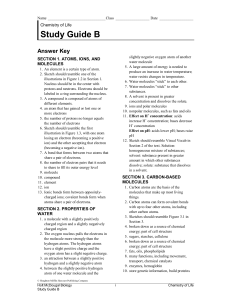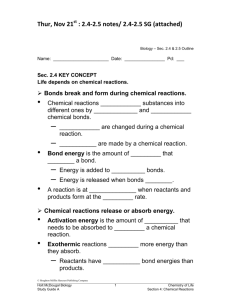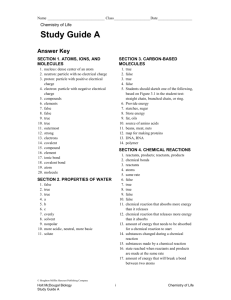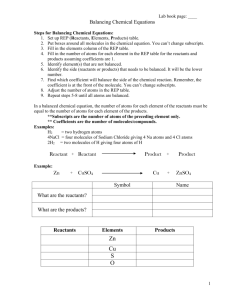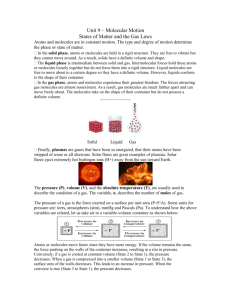Chemistry Study Guide B Answer Key
advertisement
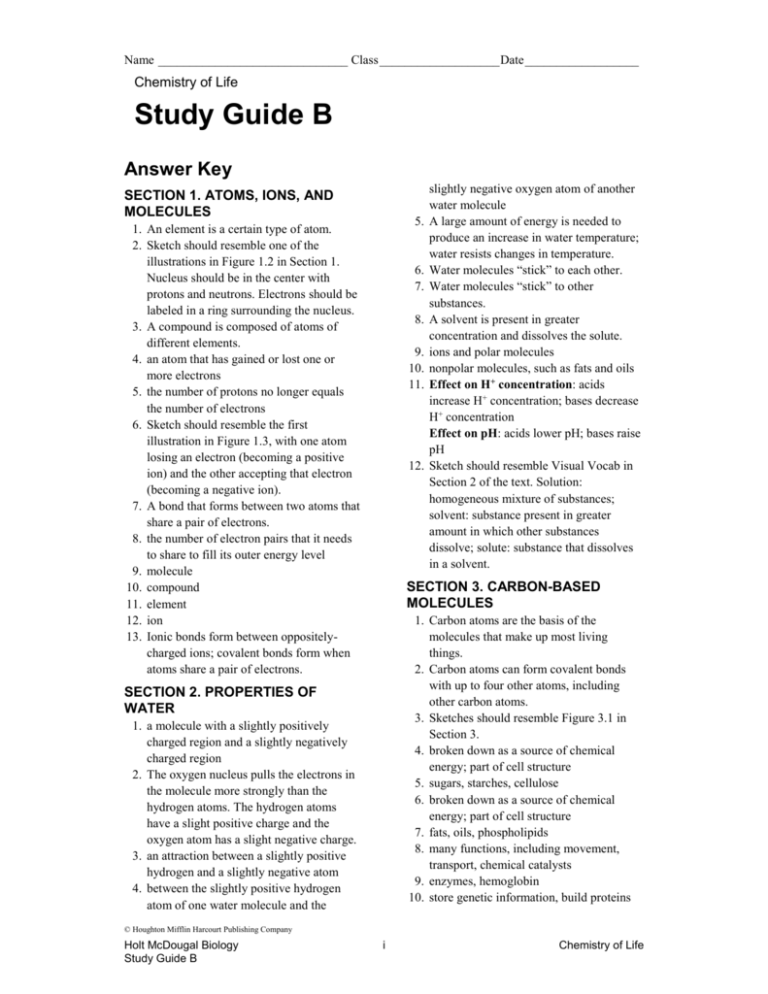
Name ______________________________ Class ___________________ Date __________________ Chemistry of Life Study Guide B Answer Key SECTION 1. ATOMS, IONS, AND MOLECULES 5. 1. An element is a certain type of atom. 2. Sketch should resemble one of the illustrations in Figure 1.2 in Section 1. Nucleus should be in the center with protons and neutrons. Electrons should be labeled in a ring surrounding the nucleus. 3. A compound is composed of atoms of different elements. 4. an atom that has gained or lost one or more electrons 5. the number of protons no longer equals the number of electrons 6. Sketch should resemble the first illustration in Figure 1.3, with one atom losing an electron (becoming a positive ion) and the other accepting that electron (becoming a negative ion). 7. A bond that forms between two atoms that share a pair of electrons. 8. the number of electron pairs that it needs to share to fill its outer energy level 9. molecule 10. compound 11. element 12. ion 13. Ionic bonds form between oppositelycharged ions; covalent bonds form when atoms share a pair of electrons. 6. 7. 8. 9. 10. 11. 12. slightly negative oxygen atom of another water molecule A large amount of energy is needed to produce an increase in water temperature; water resists changes in temperature. Water molecules “stick” to each other. Water molecules “stick” to other substances. A solvent is present in greater concentration and dissolves the solute. ions and polar molecules nonpolar molecules, such as fats and oils Effect on H+ concentration: acids increase H+ concentration; bases decrease H+ concentration Effect on pH: acids lower pH; bases raise pH Sketch should resemble Visual Vocab in Section 2 of the text. Solution: homogeneous mixture of substances; solvent: substance present in greater amount in which other substances dissolve; solute: substance that dissolves in a solvent. SECTION 3. CARBON-BASED MOLECULES 1. Carbon atoms are the basis of the molecules that make up most living things. 2. Carbon atoms can form covalent bonds with up to four other atoms, including other carbon atoms. 3. Sketches should resemble Figure 3.1 in Section 3. 4. broken down as a source of chemical energy; part of cell structure 5. sugars, starches, cellulose 6. broken down as a source of chemical energy; part of cell structure 7. fats, oils, phospholipids 8. many functions, including movement, transport, chemical catalysts 9. enzymes, hemoglobin 10. store genetic information, build proteins SECTION 2. PROPERTIES OF WATER 1. a molecule with a slightly positively charged region and a slightly negatively charged region 2. The oxygen nucleus pulls the electrons in the molecule more strongly than the hydrogen atoms. The hydrogen atoms have a slight positive charge and the oxygen atom has a slight negative charge. 3. an attraction between a slightly positive hydrogen and a slightly negative atom 4. between the slightly positive hydrogen atom of one water molecule and the © Houghton Mifflin Harcourt Publishing Company Holt McDougal Biology Study Guide B i Chemistry of Life Name ______________________________ Class ___________________ Date __________________ Study Guide B continued 11. DNA, RNA 12. the order of amino acids and interactions between amino acids (hydrogen bonds and sulfur-sulfur bonds) 13. nucleotides, which are composed of a sugar, a phosphate group, and a nitrogencontaining base 14. A monomer is a single subunit; a polymer is a molecule made of many monomers. and goes into an endothermic reaction. SECTION 5. ENZYMES 1. the amount of energy required to start a chemical reaction 2. Catalysts decrease activation energy for a chemical reaction; catalysts increase the rate of a chemical reaction; catalysts are neither reactants nor products because they are not changed or used up. 3. less 4. Why enzymes are necessary: because reactions in organisms have to occur at a low temperature (body temperature), with low concentrations of reactants, and at a high rate; Important factors in enzyme structure: order of amino acids and hydrogen bonding between the amino acids; How structure affects function: if structure changes, substrates will not be able to bind to an enzyme’s active sites; Lock-and-key model: only certain substrates bind to an enzyme’s active sites; when bound to the enzyme the chemical reaction can occur. 5. The enzyme’s shape changes slightly, which strains the bonds inside the substrate. The strain on the bonds weakens them. 6. A catalyst “dissolves” or “gets rid of ” some of the activation energy needed to start a reaction. 7. Specific substrates fit exactly into the active sites for specific enzymes, in a similar way that only a certain key will open any given lock. SECTION 4. CHEMICAL REACTIONS 1. Reactants are on the left side of the equation. They are substances that are changed during a chemical reaction. Products areon the right side of the equation. They are substances made by a chemical reaction. 2. the addition of energy to the reactants 3. the energy required to break a bond between two atoms 4. one arrow on top of another, pointing in opposite directions (also accept a sketched version of answer) 5. when a reaction takes place at equal rates in both directions 6. bond energy 7. energy, activation energy 8. lower, released 9. higher, absorbed 10. Sample answer: A chemical reaction changes reactants into products. 11. Sample answer: the energy it takes to get out of bed in the morning before you can start your day 12. The reactants and products are formed equally; the reaction is in a balanced state. 13. Energy goes out of an exothermic reaction © Houghton Mifflin Harcourt Publishing Company Holt McDougal Biology Study Guide B ii Chemistry of Life Name ______________________________ Class ___________________ Date __________________ Section 1: Atoms, Ions, and Molecules Study Guide B KEY CONCEPT All living things are based on atoms and their interactions. VOCABULARY atom ion molecule element ionic bond compound covalent bond MAIN IDEA: Living things consist of atoms of different elements. 1. How are atoms and elements related? _______________________________________________________________ 2. Sketch the structure of an atom. Label the protons, neutrons, nucleus, and electrons. 3. How do compounds differ from elements? _______________________________________________________________ MAIN IDEA: Ions form when atoms gain or lose electrons. 4. What is an ion? _______________________________________________________________ © Houghton Mifflin Harcourt Publishing Company Holt McDougal Biology Study Guide B 1 Chemistry of Life Section 1: Atoms, Ions, and Molecules Name ______________________________ Class ___________________ Date __________________ Study Guide B continued 5. Why does an ion have an electrical charge? _______________________________________________________________ _______________________________________________________________ 6. In the spaces provided below, sketch how both positive and negative ions form. Label the nucleus and the electrons. Use Figure 1.3 as a reference. MAIN IDEA: Atoms share pairs of electrons in covalent bonds. 7. What is a covalent bond? _______________________________________________________________ 8. What determines the number of covalent bonds that an atom can form? _______________________________________________________________ Vocabulary Check element compound ion molecule _______________ 9. atoms held together by covalent bonds _______________ 10. composed of different types of atoms _______________ 11. composed of one type of atom _______________ 12. atom that has gained or lost electrons 13. What is the difference between how ionic and covalent bonds form? _______________________________________________________________ _______________________________________________________________ © Houghton Mifflin Harcourt Publishing Company Holt McDougal Biology Study Guide B 2 Chemistry of Life Section 1: Atoms, Ions, and Molecules Name ______________________________ Class ___________________ Date __________________ Section 2: Properties of Water Study Guide B KEY CONCEPT Water’s unique properties allow life to exist on Earth. VOCABULARY hydrogen bond solution acid cohesion solvent base adhesion solute pH MAIN IDEA: Life depends on hydrogen bonds in water. 1. What is a polar molecule? _______________________________________________________________ 2. Explain why water is a polar molecule. _______________________________________________________________ _______________________________________________________________ 3. What is a hydrogen bond? _______________________________________________________________ 4. Describe where a hydrogen bond can form among water molecules. _______________________________________________________________ Complete the table by writing short descriptions about the properties of water. Property Description High specific heat 5. Cohesion 6. Adhesion 7. © Houghton Mifflin Harcourt Publishing Company Holt McDougal Biology Study Guide B 3 Chemistry of Life Section 2: Properties of Water Name ______________________________ Class ___________________ Date __________________ Study Guide B continued MAIN IDEA: Many compounds dissolve in water. 8. What is the difference between a solvent and a solute? _______________________________________________________________ 9. What types of substances dissolve easily in water? _______________________________________________________________ 10. What types of substances do not dissolve easily in water? _______________________________________________________________ MAIN IDEA: Some compounds form acids or bases. 11. Take notes about the characteristics of acids and bases in the table below. Characteristic Acid Base Effect on H+ concentration in a solution Effect on pH Vocabulary Check 12. In the space below, sketch a solution using the Visual Vocab in Section 2 as a reference. Label the solution, solvent, and solute. Next to these labels, write brief definitions for the terms. © Houghton Mifflin Harcourt Publishing Company Holt McDougal Biology Study Guide B 4 Chemistry of Life Section 2: Properties of Water Name ______________________________ Class ___________________ Date __________________ Section 3: Carbon-Based Molecules Study Guide B KEY CONCEPT Carbon-based molecules are the foundation of life. VOCABULARY monomer lipid amino acid polymer fatty acid nucleic acid carbohydrate protein MAIN IDEA: Carbon atoms have unique bonding properties. 1. Why is carbon often called the building block of life? _______________________________________________________________ _______________________________________________________________ 2. What ability allows carbon atoms to form a large number of molecules? _______________________________________________________________ _______________________________________________________________ 3. In the space below, sketch the three basic structures of carbon-based molecules: straight chain, branched chain, and ring. © Houghton Mifflin Harcourt Publishing Company Holt McDougal Biology Study Guide B 5 Chemistry of Life Section 3: Carbon-Based Molecules Name ______________________________ Class ___________________ Date __________________ Study Guide B continued MAIN IDEA: Four main types of carbon-based molecules are found in living things. Complete the table with functions and examples of each type of carbon-based molecule. Molecule Type Functions Examples Carbohydrate 4. 5. Lipid 6. 7. Protein 8. 9. 10. 11. Nucleic acid 12. What determines a protein’s structure and function? _______________________________________________________________ 13. What are nucleic acids made of? _______________________________________________________________ Vocabulary Check 14. The prefix mono- means “one,” and the prefix poly- means “many.” How are these meanings related to the terms monomer and polymer? _______________________________________________________________ _______________________________________________________________ _______________________________________________________________ © Houghton Mifflin Harcourt Publishing Company Holt McDougal Biology Study Guide B 6 Chemistry of Life Section 3: Carbon-Based Molecules Name ______________________________ Class ___________________ Date __________________ Section 4: Chemical Reactions Study Guide B KEY CONCEPT Life depends on chemical reactions. VOCABULARY chemical reaction bond energy exothermic reactant equilibrium endothermic product activation energy MAIN IDEA: Bonds break and form during chemical reactions. 1. Label the reactants and products in the chemical reaction shown below. Write brief definitions for these terms next to their labels. CH4 + 2O2 CO2 + 2H2O 2. What causes chemical bonds to break during a reaction? _______________________________________________________________ 3. What is bond energy? _______________________________________________________________ 4. In a chemical equation, what symbol is used to show that a chemical reaction goes in both directions? _______________________________________________________________ 5. When does a chemical reaction reach equilibrium? _______________________________________________________________ © Houghton Mifflin Harcourt Publishing Company Holt McDougal Biology Study Guide B 7 Chemistry of Life Section 4: Chemical Reactions Name ______________________________ Class ___________________ Date __________________ Study Guide B continued MAIN IDEA: Chemical reactions release or absorb energy. 6. The ____________________ of the reactants and products determines whether energy will be released or absorbed during a chemical reaction. 7. Before a chemical reaction can start, ____________________ must be absorbed by the reactants. The amount that must be absorbed to start the reaction is called the ____________________. 8. In an exothermic reaction, the products have a ____________________ bond energy than the reactants. Overall, energy is ____________________. 9. In an endothermic reaction, the products have a ____________________ bond energy than the reactants. Overall, energy is ____________________. Vocabulary Check 10. Write one sentence that uses the words chemical reaction, reactant, and product. _______________________________________________________________ 11. Write your own analogy to remember the meaning of activation energy. _______________________________________________________________ _______________________________________________________________ 12. The term equilibrium is based on two Latin roots that mean “equal” and “balance.” How do these meanings tell you the meaning of equilibrium in a chemical reaction? _______________________________________________________________ _______________________________________________________________ 13. The prefix exo- means “out,” and the prefix endo- means “in.” What do these prefixes tell you about exothermic and endothermic reactions? _______________________________________________________________ _______________________________________________________________ © Houghton Mifflin Harcourt Publishing Company Holt McDougal Biology Study Guide B 8 Chemistry of Life Section 4: Chemical Reactions Name ______________________________ Class ___________________ Date __________________ Section 5: Enzymes Study Guide B KEY CONCEPT Enzymes are catalysts for chemical reactions in living things. VOCABULARY catalyst substrate enzyme MAIN IDEA: A catalyst lowers activation energy. 1. What is activation energy? _______________________________________________________________ _______________________________________________________________ 2. Take notes about catalysts in the chart below. In the first two boxes, write detail notes about the main functions of catalysts. In the third box, write a detail about another characteristic. A catalyst lowers activation energy. 3. When a catalyst is present, more / less activation energy is needed to start a chemical reaction. _______________________________________________________________ © Houghton Mifflin Harcourt Publishing Company Holt McDougal Biology Study Guide B 9 Chemistry of Life Section 5: Enzymes Name ______________________________ Class ___________________ Date __________________ Study Guide B continued MAIN IDEA: Enzymes allow chemical reactions to occur under tightly controlled conditions. 4. Take notes about enzymes by filling in the Main Idea Web below. Why enzymes are necessary: How structure affects function: Enzymes Important factors in enzyme structure: Lock-and-key model: 5. How do enzymes weaken the bonds in substrates? _______________________________________________________________ _______________________________________________________________ Vocabulary Check 6. The word catalyst comes from the Greek word meaning “to dissolve.” How does this definition relate to the meaning of catalyst? _______________________________________________________________ 7. How are substrates like keys and enzymes like locks? _______________________________________________________________ _______________________________________________________________ © Houghton Mifflin Harcourt Publishing Company Holt McDougal Biology Study Guide B 10 Chemistry of Life Section 5: Enzymes
